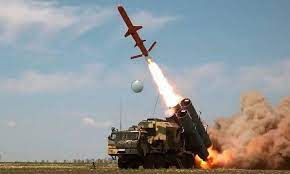As the following account explains, the Ukrainians tracked the ship from land. They launched a Bayraktar drone to distract the Moskva's main 180 degree radar, then fired a truck-based anti-ship Neptune missile under cover of a rain storm which, combined with the missile's wave-skimming altitude and rough seas, prevented the ship's other radars from identifying it. When it struck home, the ship's on-deck missiles, powered by highly flammable rocket fuel, caught fire and burned hot enough to melt steel, thwarting any attempt to put out the flames. 54 of the ship's 485-member crew have been reported rescued by a Turkish vessel which was passing by. It is the largest warship sunk since WWII. JL
ChrisO reports in Twitter:
How did Ukraine do it? A brilliant combination of tactics and awareness of Russian weaknesses. The attack took place during a storm. This would have helped conceal shore-based activity from observation. The Ukrainians used a Bayraktar TB-2 drone to distract the Moskva (whose) air defence radar only has a 180 degree field of vision. The Ukrainians purposefully got the Moskva to point its best radar (at the drone) while Neptune missiles sneaked under the coverage of other radars. In the storm, they couldn't distinguish the sea-skimming Neptunes from wavetops. Moskva is the biggest warship lost since WW2 and the first Russian flagship lost since Tsushima in May 1905.The sinking of the Russian Black Sea flagship Moskva is likely to go down in history as one of the most audaciously successful attacks in modern naval history.
The Moskva will be the biggest warship lost since WW2: at 12,490 tons she's bigger than Argentina's General Belgrano, sunk by the Royal Navy in 1982 and the first Russian flagship lost since the battleship Knyaz Suvorov at Tsushima in May 1905.
Apart from the symbolism of her likely loss, she's of great military value as a platform for air defence and missile bombardment of land targets. Her loss is of great significance to both sides. She will likely be irreplaceable - the only ship of her class, built in Ukraine (!) in 1979. Russia can't transfer warships from elsewhere to replace her as Turkey has closed the Bosphorus to military traffic.
So how did Ukraine do it? Early reports suggest a brilliantly effective combination of tactics, strategy and the exploitation of its own capabilities, combined with awareness of Russian weaknesses.
The Moskva was reportedly struck by Ukrainian-designed Neptune anti-ship cruise missiles. These only entered service in 2019. They apparently hadn't seen action before in this war.
According to early reports, the attack took place during a storm. This would have made flying difficult but also helps to conceal shore-based activity from observation. The Russians wouldn't have seen the preparations.
Reportedly, the Ukrainians used a Bayraktar TB-2 drone to distract the Moskva. The Ukrainian Navy introduced TB-2s into service in August 2021. In naval use, they can be employed to find enemy ships and relay their positions to coastal missile batteries, as well as carrying out direct attacks using their own payloads.
It's possible that the Ukrainians used a TB-2 to identify and target the Moskva for the Neptune battery. Or it could have been a sacrificial pawn to distract the cruiser. Or both! (I don't know if the TB-2 survived.)
How did the Russians not see the incoming Neptunes? The Moskva has/had a single main air defence radar - a 3P41 Volna phased array to guide S300 missiles. Problem is, it only has a 180 degree field of vision.
360 degree coverage is provided by MR-800 Voshkod/Top Pair 3-D long range air search radars for shorter-range SA-8 missiles. But it's likely that in the storm, they couldn't distinguish the sea-skimming Neptunes from the wavetops. So it's likely that the Ukrainians purposefully got the Moskva to point its best radar in the wrong direction while the Neptunes sneaked under the coverage of the other radars.
As for the Moskva - the Russians say it caught fire and the (surviving?) crew were evacuated. No crew means no damage control, which means an uncontained fire.
The Ukrainian missiles didn't necessarily have to penetrate the hull to cause this. Ships of Moskva's class have a lot of armament on their decks, potentially vulnerable to enemy strikes.Once ignited, they can't be suppressed as they contain both oxidiser and fuel. They'll burn until exhausted. They also burn extremely hot - as much as 3000°F (1650°C), hot enough to melt steel.
(And) it's been well known for years that Russia's missile cruisers have inadequate fire suppression systems, and this has been reported in the Russian military press
The Lithuanian Defence Minister, Arvydas Anušauskas, has posted an account of the sinking: "A SOS signal was given from the Russian cruiser "Moskva" at 1:05; [at] 1:14 the cruiser ship was lying on the side and half an hour later all power went out. ... As of 2 o'clock at night, a Turkish ship evacuated 54 sailors from the cruiser and at around 3 o'clock at midnight Turkey and Romania reported that the ship had completely sank. ...
Related Russian personnel losses are not yet known, although there were 485 people in the ship's crew (66 of them soldiers)."






















0 comments:
Post a Comment